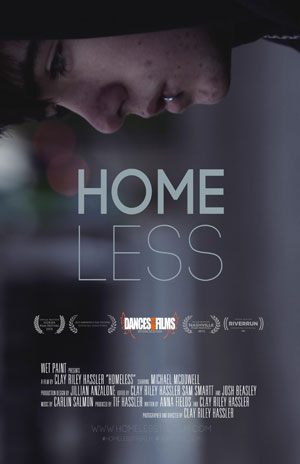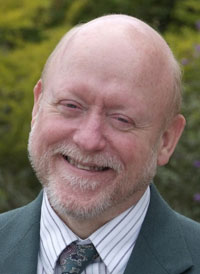 Pictured: At its West Coast premiere, "Homeless" took home the Grand Jury Award for best film at the 18th Dances With Films Festival in Los Angeles. Pictured are (from left) writer/director Clay Riley Hassler, producer Tif Hassler, Michael McDowell (Gosh) and Hosanna Gourley (Krystal). (Photo provided by Jean Souders, Dances With Films)CLEMMONS — Michael McDowell, a recent graduate of Bishop McGuinness High School, is a musician. He plays the guitar and has spent many hours in a recording studio. Over the past few months, he's also spent a fair amount of time on the film festival circuit – but not as a musician. As an actor.
Pictured: At its West Coast premiere, "Homeless" took home the Grand Jury Award for best film at the 18th Dances With Films Festival in Los Angeles. Pictured are (from left) writer/director Clay Riley Hassler, producer Tif Hassler, Michael McDowell (Gosh) and Hosanna Gourley (Krystal). (Photo provided by Jean Souders, Dances With Films)CLEMMONS — Michael McDowell, a recent graduate of Bishop McGuinness High School, is a musician. He plays the guitar and has spent many hours in a recording studio. Over the past few months, he's also spent a fair amount of time on the film festival circuit – but not as a musician. As an actor.
In what is his first acting gig, McDowell has been cast as the lead role of an independent film produced and shot in Winston-Salem that has been earning rave reviews from critics.
"Homeless" is based on a true story about an 18-year-old named Josh who endures the soul-crushingly empty days and lonely nights living on the streets and in homeless shelters. Like a lot of kids his age, Gosh's life is marked by one step forward, two steps back, but when his life "steps back" there's no one there to catch him. No family to pick him up, no home to return to.
The film, which had its East Coast premiere at the RiverRun International Film Festival in Winston-Salem, has won outstanding reviews both for the film's depiction of teen homelessness and in particular for McDowell's performance. "Homeless" recently had its West Coast premiere at the Dances With Films festival in Los Angles and took the coveted Grand Jury Award for best feature film. That's pretty amazing for a first time actor who had no expectations when he went to the casting call, of anything other than supporting his older sister Megan for her audition and maybe landing a part as an extra.
"I was pretty surprised when they called me back," McDowell said. "They called me back two times to read with other people."
Clay Riley Hassler, the film's writer and director, and his wife, producer Tif Hassler, said when McDowell first walked in to the auditions they dismissed him as looking too young for the part. (McDowell was 16 at the time.)
"He still had quite a bit of youth in his face... but then when he read he was fantastic. We put him through some pretty rigorous call-backs," Clay Hassler said.
Both Hasslers agreed that when McDowell is on screen, "he just shines."
So, the Hasslers said, they took a chance and cast an untested actor to carry a film that for the most part, would rest entirely on that actor's ability to draw people into a world they don't really want to believe exists: teen homelessness. They told McDowell to start growing out his hair and tell his mom they were going to dye it blond and, by the way, give him a lip ring.
The primary shooting was done over 15 days on the streets of Winston-Salem and at Samaritan Ministries Samaritan Inn Shelter, a homeless shelter for men organized by five downtown Winston-Salem churches.
McDowell had been to the shelter before with his father to deliver pies for Thanksgiving, but he hadn't gone inside. When he entered the shelter the first time for shooting, he said, he just felt an overwhelming sense of sadness.
"People there... they had no place to live. No place to live... and really nothing to call their own."
"At the shelter," he said, "you have to leave in the morning after breakfast and can come back at night around six or seven o'clock. In between, you're just on the street."
The staff and clients at Samaritan Ministries knew why they were there and supported the film project, he added. "The people you see in the background, all the extras – they are really homeless and they let us film them."
Before the film, McDowell said, he didn't really think about young people his age being homeless. But he came to see that "in the ways that matter the most, we're the same."
 Wet Paint FilmsThe Hasslers agreed. They believed the misconceptions they both had about homeless people are probably shared by a lot of people.
Wet Paint FilmsThe Hasslers agreed. They believed the misconceptions they both had about homeless people are probably shared by a lot of people.
"At least for me, I had certain visual stereotypes growing up, in my mind," Clay Hassler said. "The panhandlers on the corner asking you for money or just sitting on a bench somewhere just watching people. So, when the real Gosh came to us, when we met him, that stereotype just got flipped on its head."
The real Gosh (whose name is spelled Josh) was articulate and incredibly positive, said Hassler.
The Hasslers met him at downtown Centenary United Methodist Church, the church they were attending while living in Winston-Salem. One day, Josh attended their Sunday school class and they became friends. They spent a lot of time talking to him, learning about his life, his experiences. Like many homeless teens, Josh had lost a lot in his 18 years. His grandmother raised him; his father was in prison and his mother was missing from his life for a long time. When his grandmother died, there were no other relatives to help him and no place for him to live. He was dropped off at a homeless shelter by the landlord who evicted him.
Josh talked to the Hasslers about writing a memoir but they were ready to make their first feature film. Josh, the Hasslers said, readily agreed to telling his story through film.
"Josh was totally on-board with us doing a film," Clay Hassler said, "but I don't think we realized the impact it would have on people."
"For Tif and I, our faith is very important to us and if you're a person of faith, this movie will resonate with you. We hope the film moves people to take action."
He added that without the help of their church, Centenary United Methodist, they would never have been able to shoot the film or finish the postproduction.
"We have submitted 'Homeless' to several more festivals in late summer and throughout the fall," Tif Hassler said. "We hope to continue to bring it to cities across the nation and eventually we hope to pick up distribution to get it into the hearts and homes of everyone."
McDowell thinks young people particularly would be interested in seeing "Homeless," as long as they keep an open mind.
"My age group is not always accepting or open," he said. "People need to have a bigger perspective and not just live in their own bubble...they need to recognize their fellow human beings." More than anything, he said, he hopes the film's impact on people will be lasting. The movie seems to really connect with people, he said and that enables them to see the person behind the homeless label, to see the individual child of God. That recognition, he said, has the potential to make a difference in the world.
"The movie isn't just a bunch of events unfolding on-screen," he said. "It's more than that. Those things that are happening, those experiences, events, are happening to someone – someone like me or you or anybody."
The important question then becomes, what can each of us do about it, he said.
"Hopefully, that's what people will come out of the theater thinking. Hopefully, they're thinking: What can I do to help someone?"
— Annette K. Tenny, correspondent
More
At homelessthefilm.com: View a trailer and learn more about the film "Homeless" shot in Winston-Salem.
 CHARLOTTE — He is an internationally known speaker, author and journalist who now serves as the editor of Charlotte-based TAN Books, but Dr. Paul Thigpen was not always Catholic, or even a practicing Christian.In his teenage years, Thigpen rejected his Christian beliefs and dabbled in the occult. He turned back to God in 1972 when he was 18, first becoming an evangelical Protestant and eventually a pastor before converting to Catholicism in 1993.
CHARLOTTE — He is an internationally known speaker, author and journalist who now serves as the editor of Charlotte-based TAN Books, but Dr. Paul Thigpen was not always Catholic, or even a practicing Christian.In his teenage years, Thigpen rejected his Christian beliefs and dabbled in the occult. He turned back to God in 1972 when he was 18, first becoming an evangelical Protestant and eventually a pastor before converting to Catholicism in 1993.
What he came to understand from that experience of turning away from God and towards the devil, and then back to God, has prompted Thigpen to write a "Manual for Spiritual Warfare" which he hopes will make people more cognizant of the spiritual battle being waged for each of their souls.
"Through these activities (in my teen years as an atheist) I began to encounter powerful, malicious non-human intelligences that didn't fit into my world view, but reminded me of certain Gospel accounts I had learned about as a child. So I went back to the Scripture in a desperate attempt to understand better what I was experiencing. That was one of the realizations that eventually led me back to faith in God in 1972.
"In a sense, you could say that I came to believe in the devil before I came to believe in God. And if there was a devil but there was no God, then I knew I was in big trouble. Encountering him sent me running back into the arms of Our Lord.
"In the years both before and after I entered the Catholic Church in 1993, I have continued to find clear evidence (unsought) that demonic powers are real and active in our world. But I also find that most people, including Catholics, either don't believe in the devil at all or are unaware that his demonic allies are at work in their lives to lead them away from God, most often through temptation."
He believes we are in a critical spiritual battle for our souls, whose outcome will determine our eternal destiny – and it is part of Satan's stealth strategy to remain unrecognized through it all.
"So, with the encouragement of my colleagues at TAN Books, I decided to write a book that would alert people to the war raging all around them and within them. Drawing from sacred Scripture, sacred tradition and the lives of the saints, I wanted to help readers identify their spiritual enemy and his strategies, then tell them about the spiritual comrades, weapons and armor that God has given us to be victorious in this battle."
The 341-page manual contains practical advice, prayers and Church resources that readers will find useful. It has been granted an imprimatur by Bishop Peter Jugis and a "nihil obstat" from Father Matthew Kauth, who is currently in residence at St. Thomas Aquinas Church in Charlotte and serves as the chaplain at Charlotte Catholic High School. An imprimatur is official permission from the local bishop to publish a book about the faith or Catholic moral teaching, and a "nihil obstat" is a judgment by an official of the Church that the book does not contain doctrinal or moral errors.
"St. Paul urges us to 'fight the good fight of the faith,'" Thigpen says, referring to 1 Tim 6:12. "Take this 'Manual for Spiritual Warfare' with you into battle."
— SueAnn Howell, senior reporter
More
At www.tanbooks.com and www.paulthigpen.com: Order the "Manual for Spiritual Warfare" and find other resources from Dr. Paul Thigpen.

